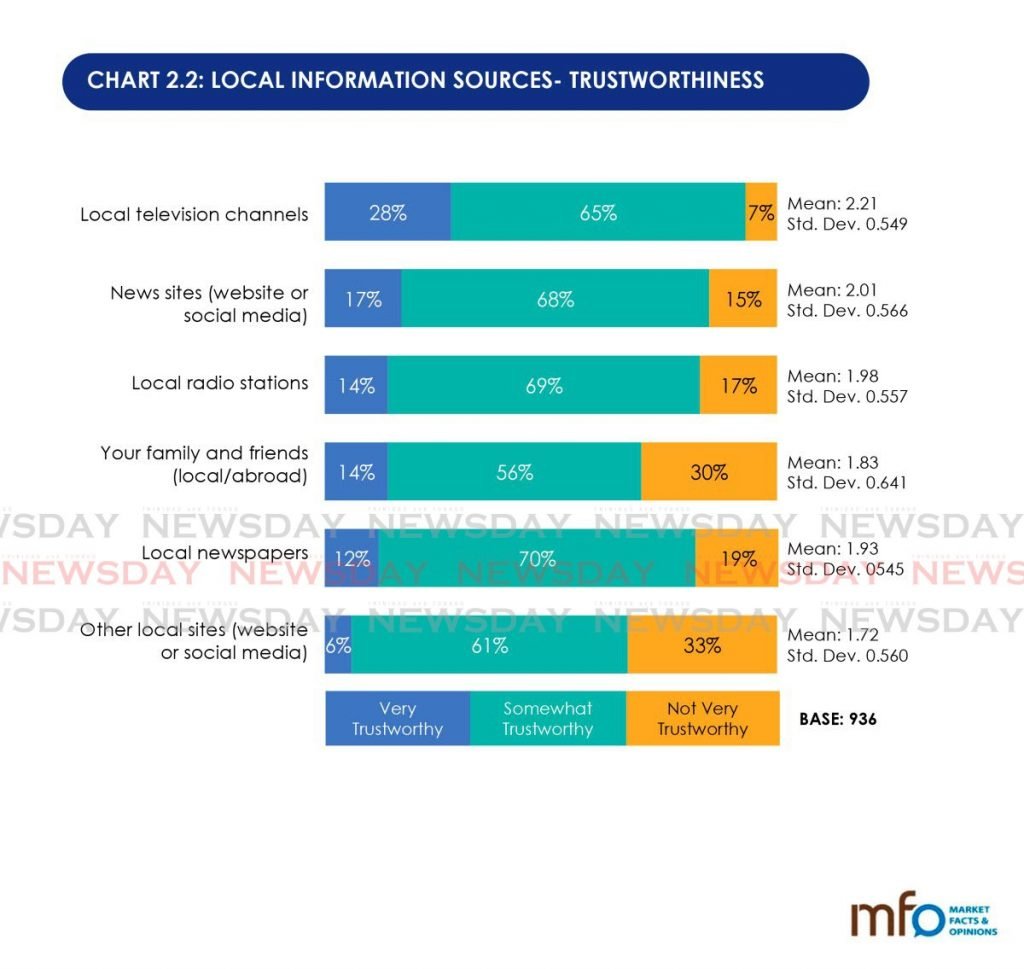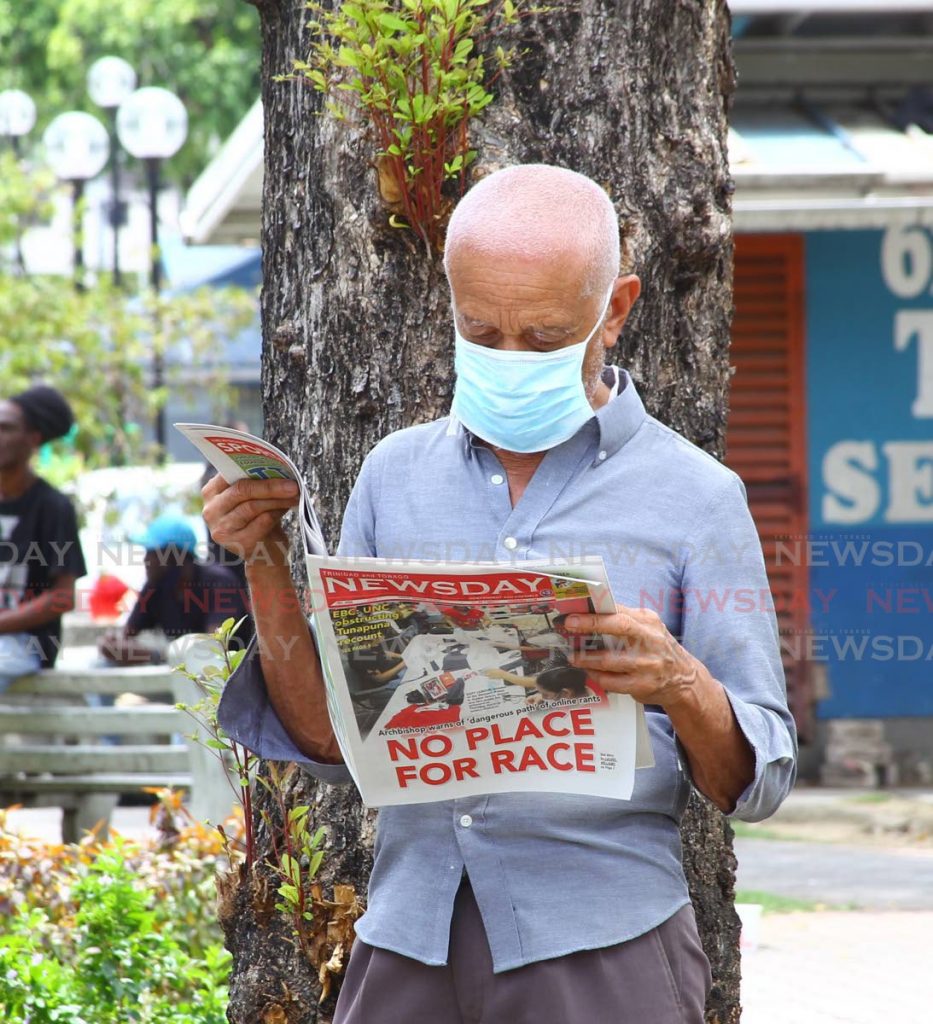Changing fortunes of media in TT

OVER the past ten to 15 years, several newspapers with large readerships across the globe have closed due to low advertising and sales.
TT too has been affected, with all three daily newspapers laying off workers in the last five years.
In a letter dated May 28, Newsday furloughed (temporarily laid off) several workers from June 8 to August 31, citing issues surrounding the covid19 pandemic. Then, on September 14, the paper's publishers announced restructuring plans to cut costs because of “dwindling” numbers in advertising and subscriptions, with plans to retrench staff across the company and to outsource printing.
Grant Taylor, TT Publishers and Broadcasters Association (TTPBA) president, and Newsday managing director said, “I think the outsourcing of the print will be a benefit because our labour costs per page have increased 200 per cent in the past five years... So in five years, with circulation down, the thickness of the papers being down (less advertising), labour costs have not changed at all. That’s just not a sustainable model.”
However, newspapers are not the only ones in trouble as TV and radio too have seen a decline in advertising, and covid19 and its resulting restrictions have exacerbated the situation.
Media InSite Ltd reported that since March 1, radio has seen the biggest decline in revenue, followed by newspapers and then TV.
"Traditional media advertising investment was already trending below last year’s totals when Trinidad and Tobago issued its stay-at-home order in late March. But since the lockdown, the percentage change in investment has plunged. While investment the second week of April 2019 had turned sharply upward, this year’s investment during the same period is 54 per cent lower."

Media InSite said that from March 22 to April 18, about 60 per cent fewer advertisers were active compared to 2019, with the total number of advertisers dropping from 1,408 in 2019 to 885 in 2020. Those who advertised in both years did so with reduced frequency: 70 per cent less in 2020 for newspapers, and 59 per cent less in radio and TV.
And the trend is similar across the Caribbean.
Media InSite compared traditional media advertising activity of the second quarter of 2019 with that of 2020, during the first wave of the pandemic, in four Caribbean countries.
It said advertising at Barbados media houses declined by 54 per cent; nearly 40 per cent in Jamaica and TT; and in Guyana, by 26.5 per cent.
Traditional/online balancing act
Executive chairman of Lonsdale Saatchi and Saatchi Advertising Agency, Ken Attale, agreed that there has been a “big contraction” in the industry.
He said ad agencies have to know “who is paying attention to what” so they know when and where to place ads in various types of media. Part of the problem in the industry, he said, is that the TTPBA does not understand the value of having research.
Another issue is that, with the emergence of online media, especially over the past five years, there has been an erosion of advertising in traditional media that was worsened by covid19.
“Clients believe they could get bigger bang for their buck out of online media, that they could spend a lot less and get the same amount of mileage as they do for spending the big money on traditional media, which is not true.”
He said people use “pay-per-click” where there is no cost to place an ad, but rather advertisers pay publishers a fee each time a user clicks on it. He said advertisers could get 10,000 clicks and think they got a lot of engagement but it could be children clicking on the ad, people who were curious but would never spend money on that service or product, people clicking by mistake or other instances where it would yield no result.
He stressed that one cannot just “go on and drop and ad somewhere.” Instead, there is a skill to digital advertising where one has to understand the audience, find out where to place an ad to reach the target audience, determine what does not work and replace it with something that does.
What was necessary in TT’s market, he said, was a mix of cross media advertising.
Survival of the fittest
Taylor acknowledged that advertising agencies too have closed or struggled because of the decline in advertising.
Any time the economy struggles, he noted, one of the first budget items an organisation usually cuts is advertising. In addition, because of the covid19 shut down, many places have closed down and those who remain do not feel the need to advertise because they are the only places open.
Another challenge for traditional media is social media and technology companies like Google.
“A lot of advertising dollars go toward these companies. They keep almost all of the revenue. Very little is shared to the companies that advertise. And these conglomerates, they have no presence here, they pay no taxes here, they employ no people here, but they generate vast incomes here and they pass very little of it on to the people doing the actual work.
“The content on our websites generates viewership for these people to sell advertising. It’s time the government looks at some sort of legislation to protect the local industry because it’s only going to get worse.”
In addition, local companies can and do go directly to Google to book advertising so their clickable ads can show up in people’s search results.
Taylor said while society is moving more towards digital and even though readership has declined significantly over the past ten years, he believed that in TT, print advertising is still the best value for money because of the circulation and the trust people have in newspapers.

“At a minimum, an online advertising programme should incorporate some print advertising to (complement) it.”
Taylor believed the decline in readership was natural with the progression to a digital world as products, consumers and consumer needs have changed.
“The younger you are the quicker you want the information, the more concise you want the information and the more visual you want the delivery system to be, so I think it’s a changing audience.”
He said a lot of digital reading is done on smartphones but many people prefer print form when reading long features or investigative reports.
“I don’t think print will die but I think it will make a significant change. It will become a different product because there are still people who like to hold paper in their hands to read. Even some young people prefer to hold magazines, books, and so on.”
On the broadcast front
Kiran Maharaj, managing director of Caribbean Lifestyles Communications (three radio stations) and former TTPBA president, said revenue for radio has been relatively consistent with no growth over the past three years but revenue for TV has dropped.
She said the Telecommunications Authority (TATT) asked 13 stations to change their frequencies to make room for others but, at the moment the stations cannot afford the technical and re-branding costs associated with such a move.
“With radio revenue not increasing, 35 stations have to survive on a limited amount of money and many are already struggling. Because you add stations does not mean you are going to get more money. And the new stations will not do well because advertisers will not take a risk on something that is new in this environment. They would prefer to advertise with stations that already have a market.”
The situation with TV was comparatively worse, she said, because TV ads were more expensive to produce and some people do not want to pay that cost of actors, make-up artists, camera and lighting people, video editors and more.
In addition, of the ten local TV broadcasters, only TV6, CNC3 and TTT had terrestrial licenses where they have antennas and transmit their own broadcasts. Meanwhile, the others had agreements with cable companies, making them content providers.
“They (content providers) are much smaller operations and do not have the same overhead as the bigger operations but they are also going after ad revenue. TV advertising now is not just those ten local stations. It is also the cable companies trying to get revenue to fill all their cable channels. Everybody is fighting for the same revenue.”
She noted that traditional media have online platforms but they compete with everything else that is online. For example, there are content aggregator sites that collect information from other sources all over the internet and put it in one location for users to access.

She said someone from Guam could build a website and place hyperlinks to all the local radio stations as well as Google ads. If they did search engine optimisation on the site, it would be prominent in search results. So, if someone searched for TT radio stations, that site would appear high up on the Google search page. And when people clicked on it, they would be exposed to Google ads.
“So that person is making money off of every radio station in TT who doesn’t even know of the website, and we have no control over those Google ads.”
Maharaj said the decline in revenue this year started in the third week of March with the lockdown. All media saw advertising cancellations especially from small and medium businesses, and corporate clients changed their advertising strategies. Then there was a further, sharper decline in April and May.
“A lot of us in the sector have had to make changes. We were fortunate that our staff was understanding because we’re all in it together.”
She said radio stations had to make adjustments, such as shift changes, a decrease the number of presenters on a show, and work hours and salaries were reduced.
“Since then revenues have not gone back up tremendously. I would say we saw some pickup in August since it was an election month. But the election spend was not as much as previous elections. It did help us, but our revenue has not returned to what it has been in previous years.”
She does not believe the industry will return to how it was before covid19 within the next 12 to 18 months because of business closures, layoffs, and operational changes by business owners due to the fact that customer do not have the money to spend or their shopping patterns have changed.
She added that, with finances tight and organisations advertising less, they have become more selective about which type of media they choose. As a result, media mangers are concerned about going into a “rate war” where advertising rates would be slashed to encourage advertising – so much that overheads may not be able to be met.
Media must do better
Dr Sheila Rampersad, president of the Media Association (MATT), told Sunday Newsday in the past five years both the downturn in the economy as well as the lack of foreign exchange to purchase newsprint has affected print media.
In addition, people were less inclined to buy and read hard copy, reducing newspaper circulation to 20,000 subscriptions from an excess of 100,000 several years ago.
She argued that traditional media did not position itself properly for the move to the digital environment. She said both Newsday and CNC3 have a good online presence, but their efforts are still not sufficient.
“I don’t think there has been sufficient investment, sufficient expansion, sufficient effort, sufficient imagination, and sufficient urgency among traditional media houses to address the economic impact of digital expansion and then the near-fatal impact of covid19.”
People worldwide seem to be unwilling to pay for online subscriptions. However, she said, the NY Times and Washington Post have been reporting increases in online subscriptions during the Trump administration because of their “exceptional journalism.”
Therefore, she believed another reason for the decrease in readership, listenership, and viewership is the decrease in public confidence in journalism. She said media owners, managers and individual journalists should take responsibility for their output and address the situation.
“What will make traditional media survive at the end of the day is coming back to basics – good journalism and serving the public interest in a way that people have a degree of confidence in it.”
Regain the public's trust
One reason why trust in traditional media is declining is because people do not understand the media’s role, and how it functions so they have unrealistic expectations. She suggested media houses educate people on how both media and digital platforms work so the public can be better equipped with the tools to assess truth and reality online.
“People can no longer be passive consumers of news. They can no longer sit back and expect the filters that traditionally worked would continue to do so. The information environment today is heavily populated with lots of people, ideas, agendas, information, fake news, real news. There is a flood of information on the internet and the public has to be able to work through, and to be smart, and to be (media and digitally) literate.”
A May 2020 MFO survey showed most people felt traditional media was "somewhat trustworthy".
This confluence of factors has led to many layoffs which has affected the financial and emotional well-being of media employees, she said, including reporters, subeditors, page designers, printers, and others.
These people often find it difficult to get other jobs as some of those skills are difficult to market elsewhere. And because of the work hours and effort required by journalists, they sacrifice a lot to do their jobs and may not have strong relationships outside of the media.

She said the membership of MATT will be there for them as friends and colleagues and the organisation is attempting to find mental health professionals to work pro bono for those affected to have some degree of counselling.
Because of the layoffs, newsrooms are shrinking so there are fewer people to do more work. Reporters are expected to do multiple stories per day and are not able to work on stories in-depth. They only have the time to report what was said instead of doing more checks and investigating the issues, thereby reducing the job to reporting.
That is one reason why, she said, people rarely see investigative reports in the media – investigative reports are time consuming and journalists are not given the time to work on them.
Wesley Gibbings, executive member of the Association of Caribbean Media Workers (ACM), expressed a different yet related concern.
He said for years, in TT, the Caribbean and around the world, media businesses have been wrestling with the idea of new business models due to several challenges. These include digital transformation, small and brittle revenue bases, the advent of social media, a recalibration of economic focus, and the impact of covid19 on individuals and the society.
His concern is how the current economic climate is likely to influence the direction and quality of independent, professional journalism.
“With an eye on financial sustainability and survival, there is the strong possibility of what media watchers describe as the capture of content by influential and well-endowed political and business interests.
“This is where press freedom comes under pressure and the work of the media becomes difficult to transact in pursuit of the public interest. I don’t know how this will all end. But things are changing, whether we like it or not.”

Comments
"Changing fortunes of media in TT"